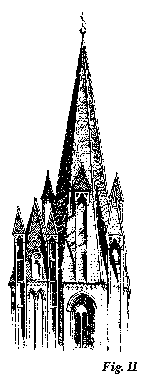I. ARCHITECTURE 43
great a complexity and play of cast shadows, that I remember no architectural composition of which the aspect is so completely varied at different hours of the day.* But the main thing I wish 
22. Nor is the spire the only ecclesiastical form deducible from domestic architecture.1 The spires of France and Germany are associated with other towers, even simpler and more straightforward in confession of their nature, in which, though the walls of the tower are covered with sculpture, there is an ordinary ridged gable roof on the top. The finest example I know of this kind of tower, is that on the north-west angle of Rouen Cathedral (fig. 12); but they occur in multitudes in the older towns of Germany; and the backgrounds of Albert Dürer are full of them, and owe
* The sketch was made about ten o’clock on a September morning.2
1 [On the connexion between domestic and ecclesiastical architecture, see Stones of Venice, vol. ii. ch. iv. § 53, ch. vi. § 84 (Vol. X. pp. 119, 248).]
2 [Ruskin was at Coutances in 1848. Writing thence to his father (Sept. 12) he says: “The cathedral here is full of interest, but a little too much like Salisbury;” and again (Sept. 13):-
“This is a beautiful place, like all the rest of Normandy that we have seen,-hills and vales and rocks breaking out here and there, and soft
[Version 0.04: March 2008]